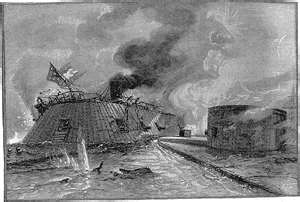The USS Monitor was the first purpose-built heavy metal warship in the U.S. Navy. Launched on January 30, 1862, the Monitor is most famous for its Civil War battle with the CSS Virginia, a Confederate States Navy ship that was rebuilt from the frigate USS Merrimack. (Thus, even though the ironclad battle is commonly referred to as the Monitor vs. the Merrimack, it is technically correctly labelled the Monitor vs. the Virginia.)
After learning of the conversion of the Merrimack into the Virginia, the U.S. Navy had to have its own ironclad and so ordered the construction of one from scratch. Based on a design by Sweden's John Ericsson, the Monitor had a split-level hull, with a big circular gun turret on the top level. The turret rotated, a feature that was as new to ship warfare as the overall ironclad design. Mounted on top of the turret were a pair of 11-inch guns, each weighing 16,000 pounds. A steam-powered propeller drove the ship, which was large enough for a crew of a few dozen.
 The Navy dispatched the Monitor to deal with the Virginia, which had been harassing the ships of the Union blockade; and the two ironclads met in combat at the Battle of Hampton Roads on March 9, 1862. Neither boat sank the other; for the most part during the four-hour barrage, the bullets bounced right off the iron hulls. At one point, the Virginia tried to ram the Monitor, but the damage was minimal; in fact, the Virginia did more damage to itself.
The Navy dispatched the Monitor to deal with the Virginia, which had been harassing the ships of the Union blockade; and the two ironclads met in combat at the Battle of Hampton Roads on March 9, 1862. Neither boat sank the other; for the most part during the four-hour barrage, the bullets bounced right off the iron hulls. At one point, the Virginia tried to ram the Monitor, but the damage was minimal; in fact, the Virginia did more damage to itself.
The two ships never met in battle again, although they came close a couple of times. The Confederate Navy eventually scuttled the Virginia after it had sustained too much damage. The Monitor took part in a Union bombardment of Confederate batteries at Drewry's Bluff on May 15, 1862 but did little damage; the Monitor also played a supporting role in defending other Union ships during the Peninsula Campaign.
In the end, the Monitor didn't live long, either: Lost in a storm, it sank off Cape Hatteras, N.C., on December 31, 1862. Of the 62 crewmen onboard, 16 did not escape.
Other ironclads patrolled the Mississippi River for the Union Navy and played a vital part in the bombardment of several key Confederate batteries. By the time the Civil War ended, in 1865, the U.S. Navy had about 50 ironclad ships.
Other countries built ironclads. Great Britain, France, Germany, Japan, and Russia all had their own designs for metal-adorned fighting ships in the late 19th Century and early 20th Century. The term "ironclad" gradually gave way to "armored cruiser" and "battleship."